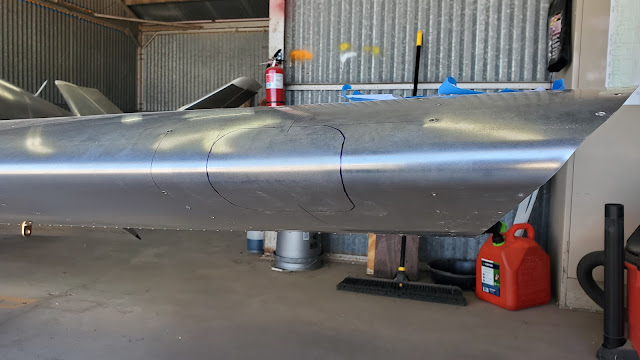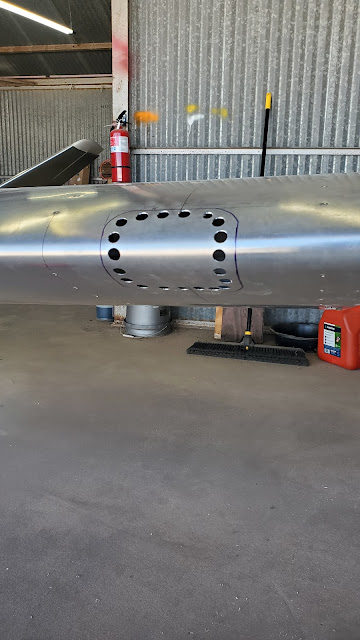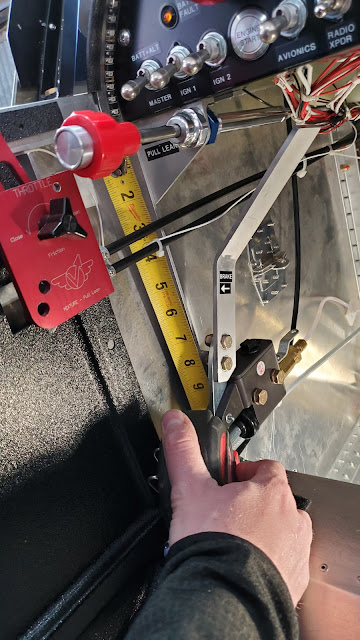36 hours
Well it took a few months but I got my replacement left wing! I did an insurance claim and just ordered a whole quick-build left wing box assembly from Sonex. It was expensive and took a while to get, but I wouldn't have been able to build a new wing that fast anyway with everything else I have going on this Spring.
Anyway, part of the challenge was just getting the wing from the factory to me. They had some issues with their normal freight carrier, so in the interest of time I got Sonex to ship the wing in a PODS container, which was a lot more expensive than normal but the other option was to just wait an indefinite amount of time and I needed to get on with it!
So what I replaced was just the wing box. The flap and aileron were good, as well as the pushrods, wiring, landing light, and wingtip light. Below is a list of all the tasks that I did, and how many hours they each took. This was kind of my to-do list, and then I just wrote down how long each thing took as I went.
Remove both wings - 1.5
Remove flap, aileron, and pushrods - 0.5
Drill out and remove wingtip rib - 0.5
Remove landing light & parts - 0.5
Disconnect & remove wiring from leading edge - 0.5
Match new wing to right wing and drill 2x main spar holes - 3
Run wiring through leading edge conduit - 1
Install wire connectors - 0.5
Install inspection cover w/ nutplates - .5
Install flap hinge - 1
Install flap - 0.5
Install aileron hinge - 1
Rivet trailing edge - 1.5
Install long aileron pushrod - 0.5
Install both wings on fuselage w/ 2x main spar pins - 3.5
Rig and drill aft spar hole to carry-through - 0.5
Connect and adjust flap pushrods - 1
Install aileron & short pushrod - 0.5
Connect and adjust aileron pushrods - 2
Install inspection covers - 5 minutes
Put interior back together - 0.5
Fit wingtip light to wingtip rib - 1
Cut hole in leading edge for landing light - 2
Install landing light & connect wires - 3
Trim & install wingtip rib - 3.5
Trim and install wing walk doubler with gasket - 3
Install grip tape on wing walk - 0.5
Fix & install gear leg fairings - 1
Drain fuel
Redo weight & balance - 1
Once I got the new wing to the hangar I just took a week off of work and cranked it all out! Here are some pictures.
Picking up the wing from the PODS depot.
I just rented a trailer to bring it back.
In the hangar!
To drill the holes in the new main spar, I bolted the new left wing to the existing right wing through the same three 1/4" holes used for mating the spars normally. Then I used the 3/8" drill guide to drill through the right wing and then through the left wing, then updrilled that to 1/2". Then I knew that the new left spar matched the right spar, which matches the fuselage.
Running the wires through the leading edge was kind of a pain but doable.
Riveting the trailing edge and the flap and aileron hinges.
I found it really hard to get the main spar holes to line up in the fuselage well enough to get the pins inserted. I don't think this has much to do with the new wing, it was super hard when we installed the wings the last time too. This time I went and got some 1/2" rod and ground down the end to make a sort of tapered pin to help with alignment.
It was easy to forget about the wiring connections at the wing roots. If I don't tuck the wires inside the wing nicely then they get pinched and the wing won't go all the way in.
After much wrangling the wings are on again!
Working on fitting the new wingtip.
I had a much easier time now on my third wingtip than I did before. I didn't spend too excessively much time trying to make the fiberglass match up perfectly to the profile of the leading edge skin. I know now it'll never really be perfect and I can just fill the little gaps with SuperFil anyway and then it'll look just fine.
I contemplated skipping the landing light for now and trying to retrofit it later, but I decided that having the wingtip off will make it a lot easier to do now.
I didn't have the template that came with the landing light kit, but I was able to just trace the hole on the old left wing to make myself a new template to cut out.
This was really the only thing that really failed during this whole wing replacement. In the process of fitting the landing light and installing and removing the lens a bunch of times I broke the lens in half. For now I just excessively taped it back together, and I'll make a new one later.
Fitting the wing walk doubler with a 3/16" gap for the wing root gasket.
Once I got everything installed I drained all the fuel out and weighed the plane again... I'm glad I did because I found a huge error with my previous measurement. I think the tires were flexing the scales and they weren't reading the full weight. The previous result was kind of unbelievably light so this is probably much more correct. The empty weight now is 725 lbs!




















































